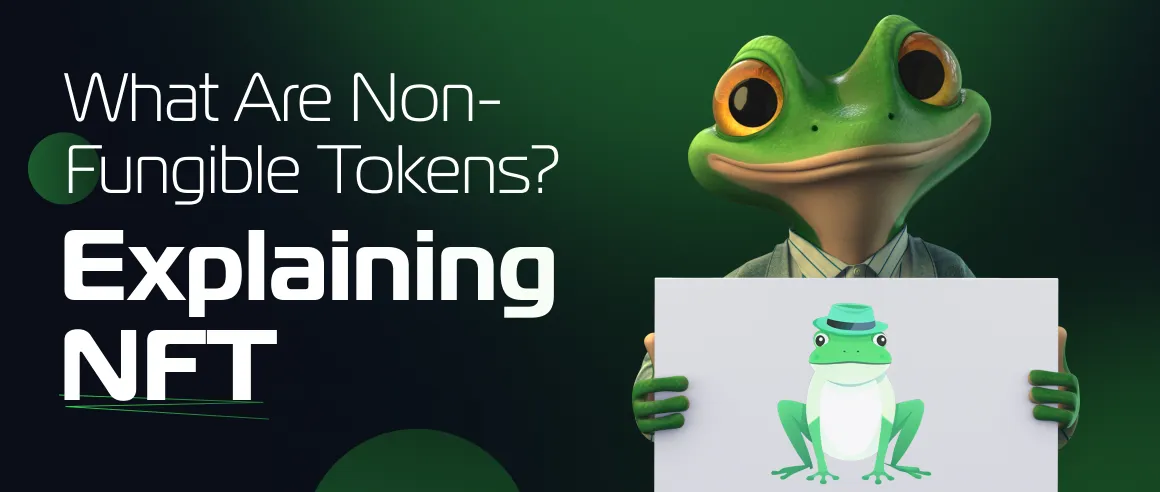We've delved into the realm of decentralized services quite a bit. DeFi, staking, and the market cap metric are all digital versions of functions in the traditional economy. Today, we will break down NFTs, a blockchain-based token that can prove your ownership of digital collectibles and art.
The concept of NFT
A Non-Fungible Token is a digital asset representing ownership or authenticity of some virtual content. Just like «real-world» items, works of art, and real estate, there are objects in the digital world that are highly valued and need some «document» proving ownership. The house you have or a car is unique. The first has an address, and the second has a VIN. Then, these objects are linked to you with registration documents. If you decide to swap houses with your friend, you must first do the paperwork.
NFT stands for this paperwork in the digital world, a second realm layering on the «real» world of traditional economy. The «non-fungible» in this acronym means that an NFT token is unique. Let’s look more into that. What is unique? When you have two bitcoins, they are equal; hypothetically speaking, you could swap them, and no one would notice anything. Because of their equality — they are the same as units of the same currency should be.
NFT, being non-fungible tokens, are not equal to each other. They represent only the property behind them and belong to the person owning the property.
NFTs are created through a process called minting. An algorithm converts files such as music, pictures, videos, or others into tokens. Minting attaches an identifier to an asset, immediately making it unique. The fact that each token is unique and the ownership is traceable makes those collectibles valuable for the market participants.
As with many innovative blockchain-based services we talked about before, NFTs operate mainly on Ethereum blockchain. Common standards for NFTs are ERC-721 and ERC-1155, which define how the tokens are created and managed. ERC-721 was the first standard for NFTs. It makes every token non-fungible and has different values. The ERC-1155 standard includes both fungible and non-fungible tokens. It is more versatile and suits creators who want to issue multiple types of tokens.
How does NFT work?
Minting, the process of NFT creation, takes a digital file uploaded by the creator to a blockchain such as Ethereum. Minting transcodes the file into a unique, non-fungible digital asset that is distinguishable from any other asset. The file is then stored on the blockchain, which is fraud- and hack-resistant, just like cryptocurrency.
Once the creator of a collectible item has put it through minting, the NFT of that item can be traded on specialized online marketplaces. Platforms like OpenSea, Rarible, and Foundation list NFTs for sale and connect buyers and sellers. The blockchain records all transactions and stores them in the ledger, keeping the transactions and any changes of ownership transparent and forever available for review.
The backbone of the NFT market is smart contracts. Self-executing contracts with terms written in the code govern the creation of NFTs and automatically enforce the terms the creator sets. Smart contracts can facilitate royalties to the creator, paying them a percentage every time the NFT is resold. Thanks to smart contracts' self-executing nature, the need for intermediaries is eliminated.
Use cases of NFT
The most prominent use case of NFTs is undoubtedly among art collectors. Digital artists have minted many of their works to sell as NFTs, with the most expensive NFT collection, The Merge, selling at $91,806,516. Such price spikes were expected in 2021 when NFTs were a booming novelty hyped by crypto enthusiasts and investors worldwide.
Beyond art, NFTs found applications in the gaming industry, confirming ownership of in-game assets such as characters, weapons, and virtual real estate. Those items were available for trading outside the games, attracting more gamers and investors. This made projects like Axie Infinity, Gala Games, and The Sandbox more functional and opened an opportunity for gamers to gain real value while playing.
Challenges and criticism
One of the major criticisms NFT faced was its environmental effect. The critics stated that since Ethereum, the main NFT blockchain, uses a Proof-of-Work consensus mechanism, all operations with NFTs take an outrageous amount of energy, resulting in excessive CO2 emissions. Indeed, everything energy-intensive has that drawback. However, in September 2022, the whole Ethereum blockchain transitioned to the Proof-of-Stake consensus mechanism, which is more energy efficient. All services based on the Ethereum blockchain, including NFT, are thereby more energy efficient.
Another challenge that NFT faced was volatility and speculation around the NFT market. When NFT emerged as an innovative investment instrument and collecting platform in 2021, the market skyrocketed at unseen speeds, attracting many believers. However, in 2023, the market, previously critically overheated, experienced a so-called implosion. Many investors who purchased NFTs, influenced by hype and market speculation, lost the value of their assets, ending up with a bunch of pictures and «the token of ownership».
This rise and fall of the NFT market raised the question of whether NFTs have intrinsic value. Additionally, many people became victims of scams when criminals sold worthless and fake NFTs were sold as originals.
The story of ups and downs, hype and apathy, is eternal. While there is not nearly as much interest in this topic nowadays, NFT technology possesses great potential as part of the emerging decentralized economy.
Tags:
Share:
